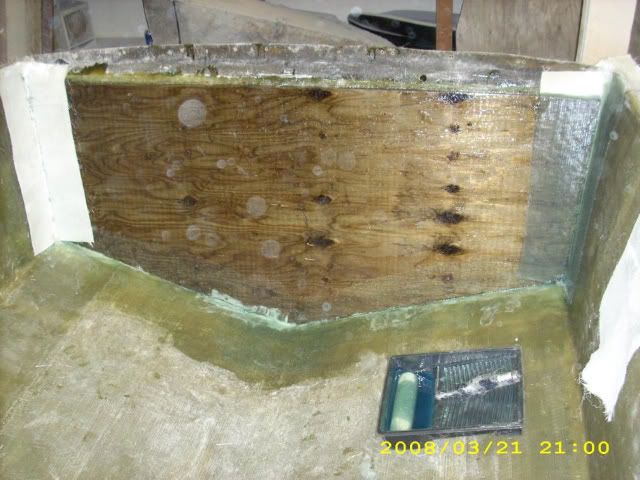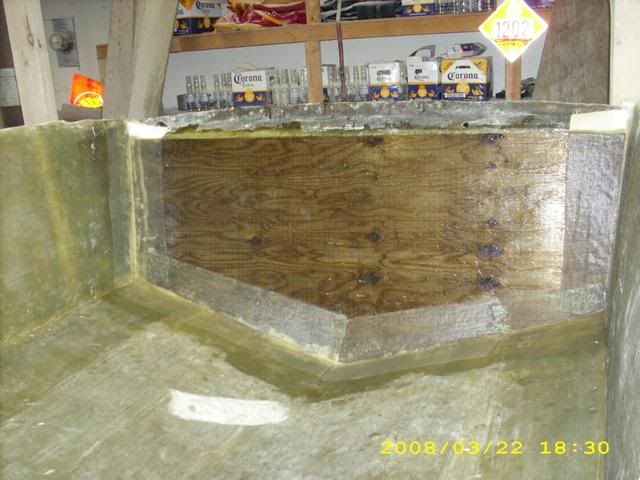Re: Question re: repairing composite/VEC hulls?
This is an update on this thread as I have now completed the Arjay 6011 Transom pour. Unfortunately, I do not have pictures of the transom tabbing, knee additions, and pour itself, but I want to give a rundown of what steps were taken. I hope that this will also provide some useful information for anyone considering Arjay/Nidabond ceramic pourable transoms.
To make a long story short, other responsibilities and time commitments led me to finally decide to sub out the glass work pre-pour and reinforcement that Oops suggested. I have a local guy in his late 60s who retired from Glassmaster who is very reasonable, and he added knees in the bilge on either side. He added several layers of mat and woven roving around the entire perimeter of the transom. I realize that 1708 would have been more bang for the buck from what I've read here, but woven is the school that he comes from I guess. In any event, he really stiffened up the transom all the way around and also reglassed the delamination on the outer portion of the inner skin. We decided to simply glass over the exposed foam from the cutout, and not bridge and inject foam back to the transom as originally it served no structural purpose, especially given the poor original design and lack of reinforcement. I figure this will keep the weight down a little as the poured transom is 75-80 lbs, whereas the original foam core was much less.
On the outer skin, I glassed in a piece of 1708 on the inside in order to seal all the holes from the inside. I had the advantage of no wood rot to deal with, so I took a 4 ft long piece of 1X4 and added stick on 40 grit sandpaper to each end was amazed at the leverage and scouring that I was able to give the inner skins in the cavity. The dust was really flying. I shop vac'd it out and found that a section of broom handle with 2 automotive rags rolled around the end length-wise and zip tied served as a great way to wipe with acetone and clean the surface.
After much reading here and on the Net, I decided to pre-apply polyester resin to the skins prior to the pour. I then used gorilla tape to dam the top of the mid transom and all the way up the sides. I used an old piece of the foam core to provide the proper cavity opening when taping. I overlapped and weaved the tape and once the pour started had zero leaks from any taped sections.
I used a road cone as a funnel. It worked great! I had a more narrow opening at the high point on top of the wing, so it fit in perfectly.
Now onto the Arjay. I bought two 5 gallon pails. I bought the square, paddle type joint compuond mixer blade from Lowes to mix with a 1/2 inch 7 amp drill. My brother helped and he added the MEKP-925 while I stirred each pail for 4-5 minutes. I mixed slightly on the slow side with 7 oz per 5 gallons at about 78 deg. I decided to stand up in the boat and pour it while my brother (with chemical goggles, gloves, and respirator) held the funnel. It poured into the cavity very fast and was only 6 inches or so from the top of the lower mid-part of the transom after the first pail. I mixed the second batch while my brother tapped on the transom with a rubber mallet to negate air pockets.
The second pail quickly brought the level up to the top of the wing I was pouring into. The other wing was still 6 inches from full, so we simply moved the funnel to the other side and filled up to the top. I "topped off" each side several times until the final settling occured.
I finished with about 1/2 inch of putty left in the bucket, and at $176 per bucket + shipping I was THRILLED at my good fortune!
It took about 45-50 minutes for the lower part of the transom to start warming. It was a very gradual and controlled exotherm. Eventually after 75-90 mins the entire transom was cooking to the point of feeling the heat radiating off the skins. You could touch it and keep your hand on a few seconds or so. It was late at night, so I put it to bed still hot after 3 hours. The Arjay was tremendously simple to pour and had the viscosity of gear lube basically. The old adage of all the work being in the prep is so true.
After thinking more about this, Arjay was the ideal solution for my boat as the floor and stringers are enclosed foam/composite. I had no old wood to remove, so it was just a matter of adding the knees and structural tabbing, and then pouring. Still, a lot of work even with sanding, cleaning, and damming the pour area!
But for ease of use for the backyard repairer, I do not see how one could beat the pourable, ceramic transom. It's really a great product. The transom today feels like concrete!
Having said that, if I had a previously wooden core transom, I wouldn't feel great about the "chainsaw method" only with the pourable concept. I've read where many remove the inner skin to properly grind and prep both surfaces, and if I was going to do that, I would just put wood back in as it would assuredly outlast particular interest in the boat. In my situation, the absence of old wood enabled me to just sand and prep the existing skins, add fresh resin, and then pour.
Hope this helps anyone debating the option of using Arjay or Nidabond.
Thanks again to Oops for guiding me through the process of options. I'll be refitting the cap in the next week or two, so let the fun continue. It's good to know that the boat will now be appreciably stronger than it was when it came from Larson. I'm still surpised I didn't lose my motor!





















